The 30 Best Nude Scenes in Film, from ‘Shortbus’ to ‘Blue Velvet’ to ‘No Hard Feelings’

“That’s not art. A striptease isn’t art. It’s too direct. It’s more direct than art.”
That line from Akira Kurosawa’s “Ikiru” sums up a lot of feelings people seem to have about nudity in film. The history of painting and sculpture is full of nude portraiture, which is regularly and comfortably classified as art. But the nude scene in movies is rarely discussed alongside a Canova marble statue or Manet’s “Olympia.” Movies blur the boundaries between “real life” and artistic indirection so thoroughly that people discuss nude scenes in movies as practically everything but art. It’s “content” that deserves an “advisory,” or something akin to “porn,” however the Supreme Court is classifying that these days.
More from IndieWire
As many have noted, the very nature of the actor’s job demands the audience look at them. So when nudity enters the (literal) picture, it complicates the relationship between viewer and viewed. Are we somehow invading their privacy? Are they invading ours? What should we feel about this parasocial interaction, particularly when it is presented in an overtly sexualized context?
At times, it can be difficult write about onscreen nudity in anything but jokey terms, especially since nudity has become a fixture of comedy. Nudity is most frequently used in mainstream entertainment as a punchline. It’s been a quarter-century since nudity was a central feature — and dramatic plot point — of what was then the most widely popular Hollywood film in decades: “Titanic.” Bared skin in a similar manner in a top blockbuster in 2024 or any other recent year seems unlikely. Although, the unsettling reaction nudity can elicit in audiences is once again getting explored with some frequency in the horror genre; see scariest scenes in the hugely popular “It Follows” and “Hereditary” for starters.
So maybe we should take nudity seriously again. One place to start that reassessment is to look at the history of the nude scene since the silent era. The best nude scenes convey vulnerability, intimacy, eros, and so much more. Below is an incomplete timeline of the nude scene throughout cinema history. All are movies that wouldn’t have the same artistic impact without these moments.
Alison Foreman, Christian Blauvelt, Christian Zilko, Jude Dry, Kate Erbland, Ryan Lattanzio, and Samantha Bergeson contributed to this story.
[Editor’s note: This list was first published in March 2022 and has been updated multiple times since.]
“Intolerance” (D.W. Griffith, 1916)
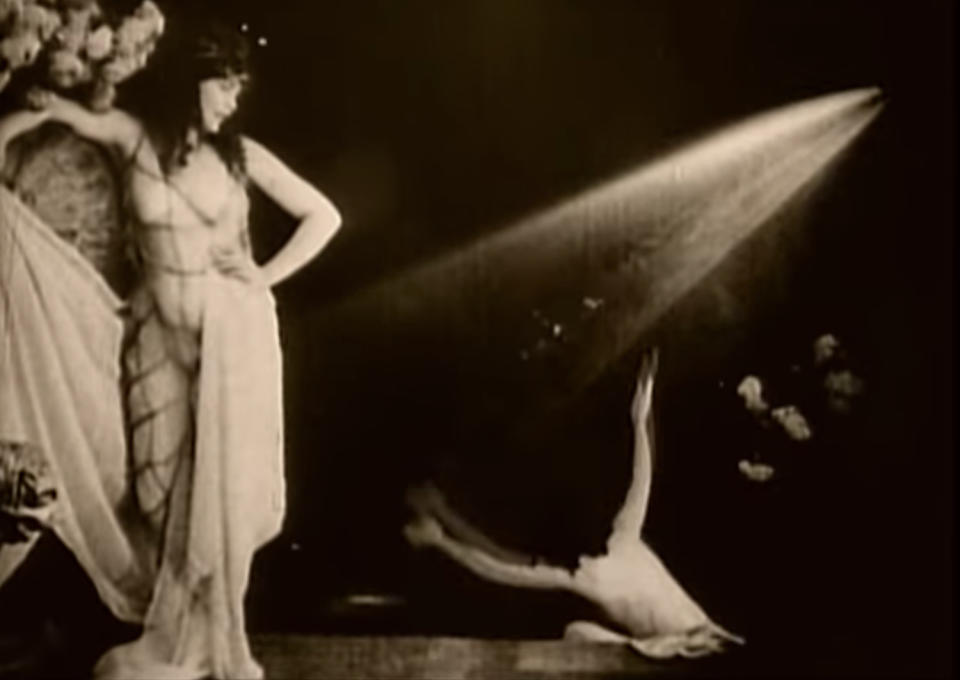
It may surprise today’s viewers just how liberated many silent films are in their depictions of sexuality. In the U.S., the self-censorship of the Hays Office wouldn’t come about until the late ‘20s (and wasn’t enforced at all until Joseph Breen took charge in 1934). Silent movies and early sound films have all manner of transgressive content. D.W. Griffith’s “Intolerance” features a full-on orgy with women wearing see-through fabrics or bathing in the nude. (Later on, during the Siege of Babylon, there’s a kiss between two men.) Some of that libertinism would pop up again in Griffith’s later “Orphans of the Storm,” and it would carry on through the early sound era with Claudette Colbert famously taking a nude bath (though only seen from the back) in asses’ milk in 1932’s “A Sign of the Cross.” But even a couple of decades earlier, Griffith was pushing boundaries in his own right. —CB
“Psycho” (Alfred Hitchcock, 1960)
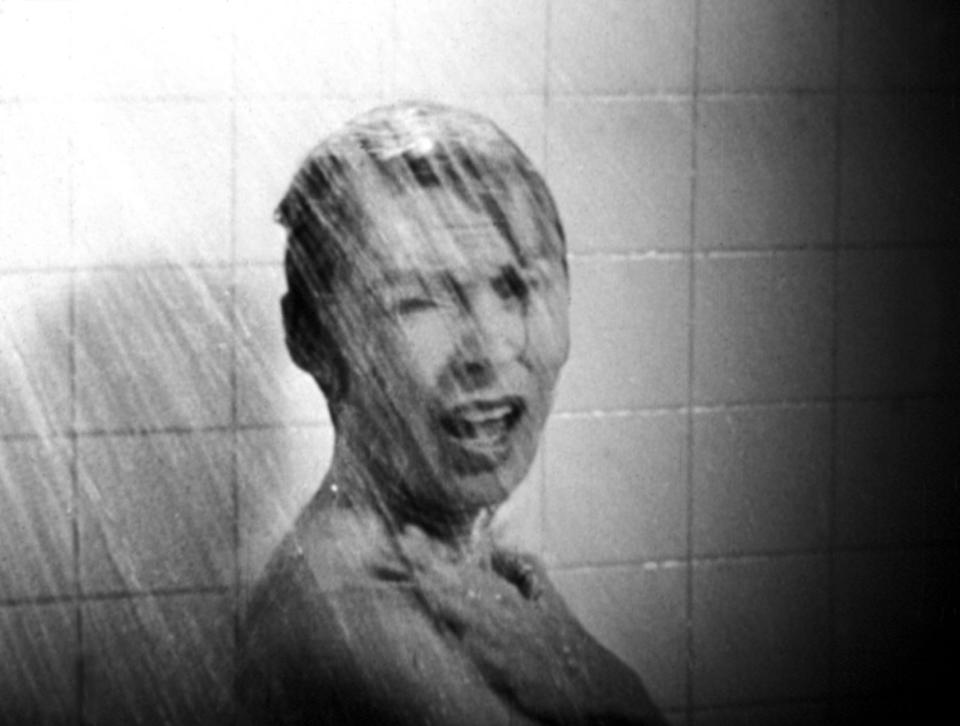
The Master of Suspense seems almost prudish in a modern context, particularly when it comes to the relatively tame first death in “Psycho.” But make no mistake: Alfred Hitchcock’s 1960 serial killer shocker, featuring Janet Leigh at her most iconic, was groundbreaking at the time and remains compelling in context.
Every cinephile knows the black-and-white sequence: a naked woman, traveling home after a tryst with her married lover, showers at a motel before a knife-wielding silhouette emerges from behind a plastic curtain and — in perfect rhythm with a section of screaming violins — savagely stabs her to death.
The notorious slaying of Marion Crane, the helpless victim imagined first for Robert Bloch’s 1959 novel of the same name, includes limited nudity. You can briefly see out-of-focus breasts towards the end of scene, but by and large Marion’s nakedness is more implied than explicitly depicted with fast cuts forcing audience eyes from shadowy shots of the killer to Leigh’s “bloody” torso and limbs in rapid succession. Hitchcock’s atmospheric flare, sharp editing, and inventiveness allowed him to skirt censorship laws in many countries. Still, some movie-goers claimed upon viewing that they’d seen more nudity than actually exists in the film.
“I stopped taking showers and I only take baths,” Leigh has said of her experience following Hitchcock’s classic, per Women’s World. “And when I’m someplace where I can only take a bath, I make sure the doors and windows of the house are locked. I also leave the bathroom door open and shower curtain open. I’m always facing the door, watching, no matter where the shower head is.” —AF
“The Last Picture Show” (Peter Bogdanovich, 1971)
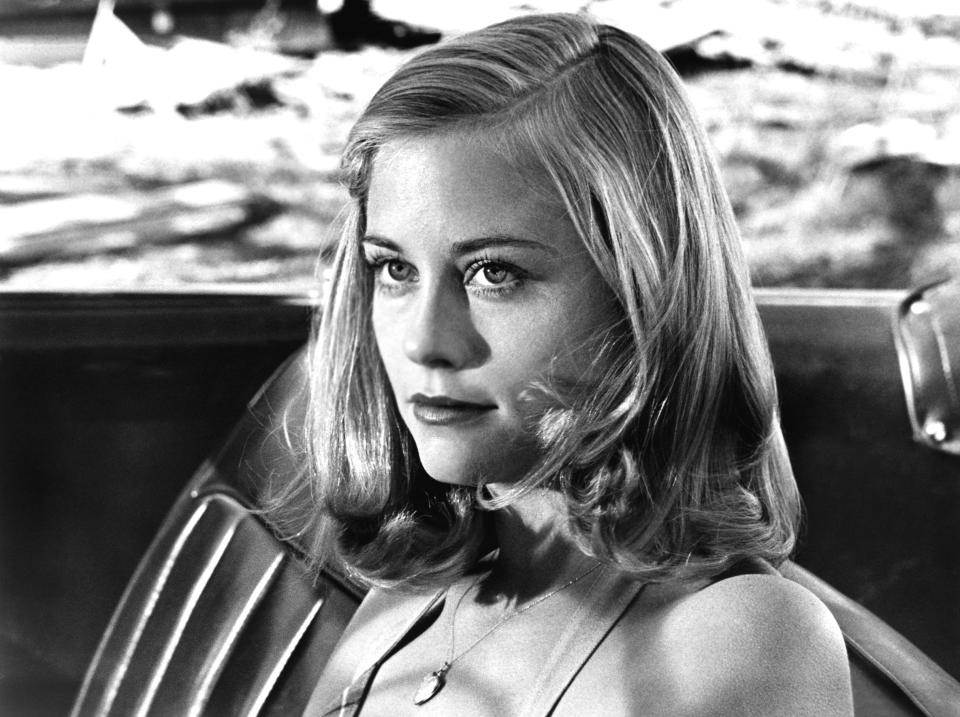
Peter Bogdanovich’s wistful black-and-white portrait of the end of an era for two high school seniors and longtime friends (Jeff Bridges and Timothy Bottoms) remains best known as the hallmark of the director’s career. The film also launched the start of Cybill Shepherd’s career, when Bogdanovich’s then-wife Polly Platt thought Shepherd would be perfect for the role of Jacy Farrow, the smartest and prettiest girl in any room of the film’s declining northern Texas oil town.
But one scene got the film banned in part of the very state in which the film was set. After a Christmas dance, Jacy is invited to a skinny dipping party, uncomfortably undressing on the diving board as rowdy teens splash around below. Shepherd was 21 years old at the time of filming, but as her character is still in high school, this was met with ire from the public. “Last Picture Show” was actually deemed obscene by the city of Phoenix, requiring it to be judged by a federal court, which ultimately ruled the movie safe for viewing. Still, it was 1971, and so even the suggestion of nudity, let alone the full monty, managed to shock casual moviegoers. —RL
“Don’t Look Now” (Nicolas Roeg, 1973)
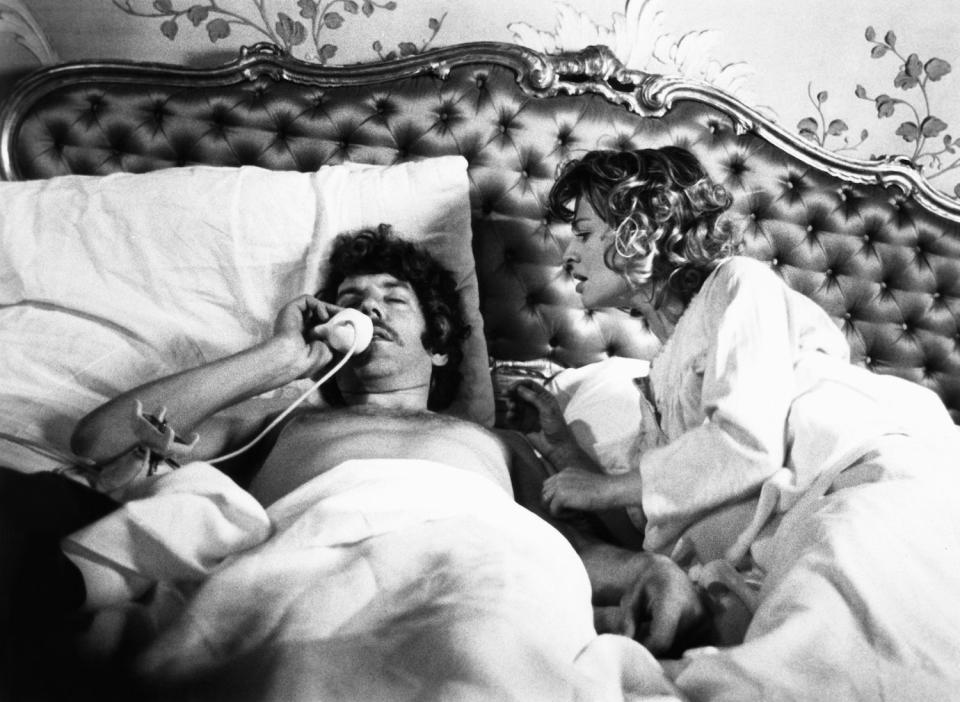
One of the most infamous sex scenes of the 1970s is a fugue of grief and hope. Donald Sutherland and Julie Christie — neither overly eroticized with the lighting and staging here, and you would never confuse this for a porn film — seek solace in each other’s bodies after they’ve just had an epiphany about the death of their young daughter, who they’ve been mourning for months. It may be cinema’s greatest “sexual healing” scene, and the way director Nicolas Roeg intercuts their lovemaking with post-coital shots of them dressing and preparing to go out afterward somehow got it past censors in the U.S. and U.K. Salacious stories about Christie’s boyfriend Warren Beatty wanting control over the edit and rumors that the scene featured unsimulated sex dominated the narrative, but it’s really a deeply felt scene about two people finding hope in each other after the darkest time of their lives. —CB
“American Gigolo” (Paul Schrader, 1980)

A crime drama about a high-class male escort feels destined to have some full-frontal nudity, but remarkably, the notorious shot of Richard Gere in the buff wasn’t supposed to be featured in Paul Schrader’s “American Gigolo.” It was Gere, who became a full-fledged sex symbol for his sharp turn as seductive Julian Kaye, who pushed to go nude for a scene where his materialistic prostitute muses about the nature of his job, feeling that it was a natural extension of the film. The resulting scene, where Kaye leans against a window stark nude after sleeping with love interest Michelle (Lauren Hutton), was one of the first full-frontal male nude scenes in a mainstream Hollywood film. And yet, the scene is surprisingly tasteful, showing Gere’s body from afar as he wistfully discusses how his work brings happiness and pleasure to his clients. While “American Gigolo’s” lasting legacy may be the millions of crushes formed for Gere it spawned, his actual nudity feels more vulnerable than sexy. —WC
“Heavy Metal” (1981)

Animated films don’t tend to feature a lot of nudity, considering how many are built for a very young audience in mind. So “Heavy Metal,” an animated anthology adaptation of the cult magazine of the same name, caused a stir when it arrived in 1981 theaters with a copious amount of cartoon topless scenes. A bit of a juvenile male fantasy, Gerald Potterton’s film really goes wild with the sexual content in the highlight segment “Den,” about a nerdy kid transformed into a musclebound hunk and sent to the world of Neverwhere, where all the women are buxum, naked, and eager to throw themselves at him. The audaciousness of the premises is near parodic, and “Den” is significantly stronger for leaning into it with tongue-in-cheek narration that makes the eroticism more amusing than anything else. Is the gratuitousness particularly artful? Not really. But that’s part of what makes “Heavy Metal” so fun. —WC
“Fast Times at Ridgemont High” (Amy Heckerling, 1982)
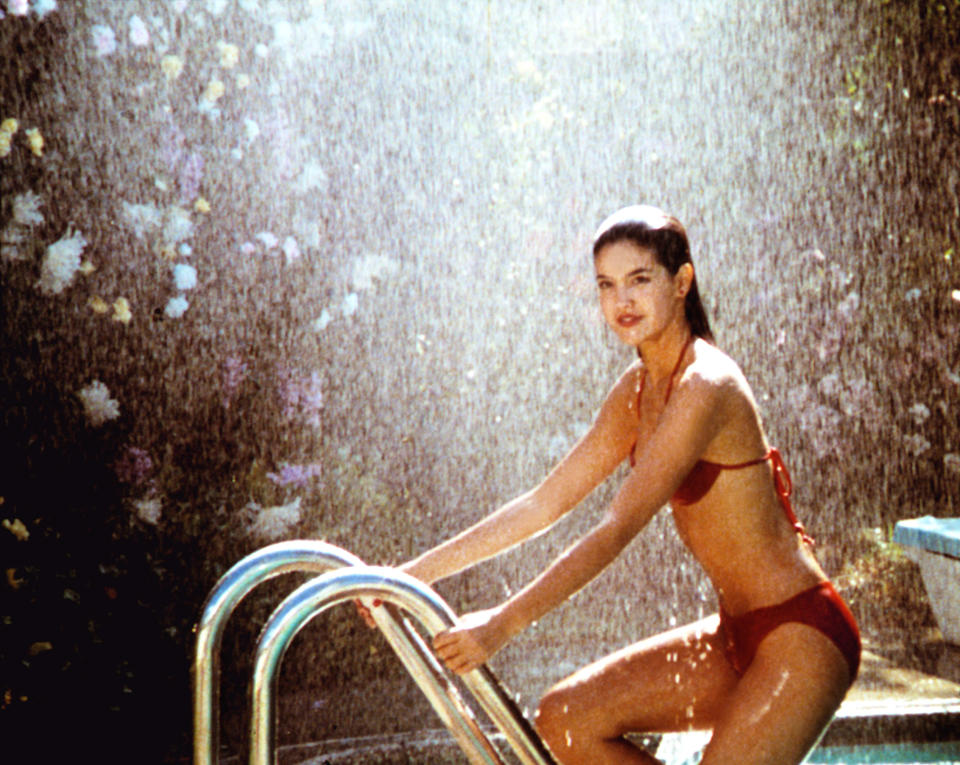
Ah, nothing feels like summer more than pent-up hormones and a little red bikini. Judge Reinhold’s teen fantasy in “Fast Times at Ridgemont High” includes an infamous topless moment featuring Phoebe Cates stripping off her teeny crimson two-piece. The 1982 classic film also stars Jennifer Jason Leigh, Sean Penn, Forest Whitaker, Robert Romanus, and even a cameo by Nicolas Cage. Director Amy Heckerling made her feature debut with the dark comedy take on the pressures of adolescence; while Heckerling went on to helm the iconic (and nudity-free) “Clueless,” David Lynch reportedly was offered “Fast Times” first. And the film wasn’t Cates’ first time going “Fast.” She previously bared her breasts in “Paradise” when she was just 17. “The topless scene in ‘Fast Times at Ridgemont High’ was funny, which made it easy,” Cates said in 1982. “In this business, if a girl wants a career, she has to be willing to strip. If you’ve got a good bod, then why not show it?” Cates also revealed in 2018 during an interview with former co-star Leigh that it was “not that big of a deal,” per Leigh’s advice. Not a big to her, but a big deal in the history of bikini drops. —SB
“A Room with a View” (James Ivory, 1985)

It may be the ultimate in high-collared, petticoat-wearing, “tennis anyone?” escapism, the Merchant-Ivory classic that’s basically what every British period drama on “Masterpiece Theatre” has aspired to be ever since. “A Room with a View” is also the greatest of its kind because it’s so much more than those twee trappings. Case in point: When Julian Sands, Rupert Graves, and the immortal Simon Callow strip naked and frolic in a shallow Surrey pond. “Let’s have a bathe!” Grave asks his companions. The full-frontal escapade is an example for the ages of letting loose and communing with nature, and of British cinema’s greater willingness to feature male nudity than that of the U.S, ever since Ken Russell’s “Women in Love” was a male nudity milestone in 1969. —CB
“Blue Velvet” (David Lynch, 1986)

Since even before George A. Romero’s “Night of the Living Dead” saw a naked zombie wandering around a field, nudity has aroused terror in horror lovers. Yes, the genre has a bad reputation for objectifying (and frequently dismembering) big-breasted women who, as famed final girl Sidney Prescott would put it, “are always running up the stairs when they should be running out the door.” But horror is a natural fit for exploring taboo subject matter; nudity is nothing if not taboo; and many, many filmmakers have successfully exploited that pairing to achieve serious moments of artistry. David Lynch has never shied away from exploring sexual violence, but his most brilliant use of nudity comes in the surrealist noir “Blue Velvet.”
When Jeffrey Beaumont (Kyle MacLachlan) breaks into a mysterious woman’s apartment, nightclub singer Dorothy Vallens (Isabella Rossellini) holds him at knifepoint and forces her intruder to strip naked in a dark role-swap that makes the already nauseating potential of a sexualized home invasion even more jarring. In a bizarre turn, Dorothy begins to seduce the terrified, naked Jefferey but is interrupted by the introduction of Dennis Hopper’s bone-chilling Frank Booth.
With Jeffrey stashed in the closet, Frank soon overpowers Dorothy, beating her and switching between personalities he identifies as “Baby” and “Daddy.” The brutality comes to a screeching halt when Frank abruptly leaves. Jeffrey emerges from the closet to hold Dorothy, a comfort she accepts only to kiss him once more and whisper, “Hit me.” It’s a feat psychosexual terror and, in so many ways, Lynch at the peak of his cinematic game. —AF
“Basic Instinct” (Paul Verhoeven, 1992)

That scene in “Basic Instinct” — you know, the panty-less crossing-legs moment that resulted in one of the most-paused moments on VHS and later on DVD and Blu-ray — has been widely tussled over. Why? Because lead star Sharon Stone alleged in her memoir that she did not realize director Paul Verhoeven had captured her “parts” in the now-iconic interrogation scene. Verhoeven allegedly asked Stone to remove her panties since her white dress was reflecting the light and ruining the shot. Yet Stone didn’t realize her genitals would be in frame, calling the final scene a “vagina-shot.” Stone reportedly slapped Verhoeven after seeing the first cut of the film; after consulting with her attorney, she ultimately decided not to sue. “I chose to allow this scene in the film. Why? Because it was correct for the film and for the character and because, after all, I did it,” Stone wrote. While Verhoeven maintained that Stone’s recollection of events was “impossible,” the scene is still what the psychological thriller “Basic Instinct” is best known for. —SB
“The Piano” (Jane Campion, 1993)

Admirers of Campion’s 19th century-set New Zealand epic have parsed its fascinating sexual dynamics for three decades. Sam Neill plays a Kiwi landowner who’s simultaneously attracted and repulsed by sex and unable to be a husband for Holly Hunter’s Scottish immigrant Ada. She strikes up a curious connection with a local played by Harvey Keitel, and he expresses his sexual interest in her almost immediately. First, he wants piano lessons, the exact number of which is the same as the number of keys on her beloved piano (which he rescued from the surf, where her husband had left it). Then he’ll trade “keys” for certain favors, culminating in him lying naked with her. The nudity in Campion’s film is largely centered on Keitel, and the way he both affronts and attracts Ada speaks to the complicated nature of sexuality itself. —CB
“Showgirls” (Paul Verhoeven, 1995)

Take your pick for the best nude scene in “Showgirls,” because that’s a good 90 percent of the film. A hedonistic, trashy masterpiece that uses the high-stakes lives of Las Vegas strippers as a metaphor for capitalism and the American dream, Verhoeven’s film is notorious for killing the NC-17 rating as a viable commercial path and receiving savage reviews as a flop. But time has been kind to Verhoeven’s campy, brilliant vision, which renders its story of Elizabeth Berkley’s striving dancer and her rise to the top as a maximalist, outsized classic melodrama and hides its shrewd consideration for these women sell their bodies for fame behind buckets of bravado. There’s so many shocking and audacious moments to obssess over, from Berkley’s aggressive and acrobatic poolside sex scene with a slimey Kyle MachLachlan to her down-and-dirty strip tease. And yet the most impactful use of nudity comes during a classic audition scene, where Berkley’s Nomi joins a parade of other girls as they take their tops off to be poked and proded by the male director of a dance revue. When she’s nearly forced to apply ice on her boobs to get her nipples erect, it’s an indignity even she can’t take, causing her to storm off. While some might see the exchange as Verhoven’s excuse to get his lead star to bare all for another scene, Berkley’s strong performance in the moment where she rejects the ice reveals the inner conflict and demons lurking behind Nomi’s ruthless quest for the spotlight. —WC
“Starship Troopers” (Paul Verhoeven, 1997)

While Paul Verhoeven’s cult classic actioner has been (rightly!) reconsidered over the years, eventually earning accolades as a stone-cold anti-fascist classic, it’s yet to pick up respect for its other hot button elements. Mainly that, even in the fog of war and amidst the constant threat of being annihilated by giant bugs, it’s pretty sexy. Kitted out with a blisteringly gorgeous assortment of stars — that the film is about teenagers going to war is painful, but it also guarantees an eye-popping cast, including Casper Van Dien, Patrick Muldoon, Dina Meyer, and Denise Richards — the film is rife with pulse-pounding scenes. And yet one stands a cut above: juiced up over yet another bug battle, Johnny (Van Dien) and Dizzy (Meyer) finally consummate their long-simmering will-they-won’t-they friendship with a banger of a sex scene. Dizzy has been in love with Johnny forever, and you’ll forgive him for taking so long to get hip to her charms, particularly after she strips down so quickly (who doesn’t wear a sports bra to war? Who cares?) and he uses her all-timer of a tee shirt for some light kink. War is hell, so is the tension. —KE
“Titanic” (James Cameron, 1997)

“Paint me like one of your French girls.” And those French girls are nude. Sure, 1997’s “Titanic” may have broken box office records at the time. It may have cemented James Cameron as an unprecedented deliverer of blockbusters. But its most iconic achievement might be lead star Kate Winslet’s sensual pose, wearing “this and only this,” i.e. the Heart of the Ocean necklace, as Leonardo DiCaprio’s Jack paints her likeness, nervous and thrown off by Rose’s bold baring-all. A PG-13 movie, “Titanic” surely introduced a wave of young audiences to nudity onscreen, but in hindsight, it also made for one of cinema’s most tenderly naked moments. —SB
“Boogie Nights” (Paul Thomas Anderson, 1997)

Paul Thomas Anderson’s ode to 1970s Los Angeles – and SoCal’s porn manufacturing hub, the San Fernando Valley – let Mark Wahlberg break out as a serious actor, thanks to a serious (prosthetic) appendage. Wahlberg starred as adult film newcomer Dirk Diggler, scouted for his elephant-like genitalia. Dirk’s descent into the seedy underbelly of the erotic film industry leads to drug addiction, crime, and even murder. Julianne Moore, Don Cheadle, William H. Macy, Philip Seymour Hoffman, John C. Reilly, Heather Graham, and Burt Reynolds star in the period piece, which was based on auteur PTA’s mockumentary short film, “The Dirk Diggler Story.” While “Boogie Nights” went on to land three Academy Award nominations in 1997, most fans remember the major reveal of Dirk’s secret weapon: his faux schlong. A 2014 Vulture oral history of the making of “Boogie Nights” revealed that the prosthetic was made of plaster, and star Wahlberg wore a custom “bulge” made out of a stocking filled with birdseed. The prosthetic ultimately was slightly less than Dirk’s 13-inch penis, but its size didn’t minimize its creepiness factor. Special makeup effects coordinator Howard Berger even called Dirk’s “diggler” a “weird monster penis.” —SB
“Eyes Wide Shut” (Stanley Kubrick, 1999)
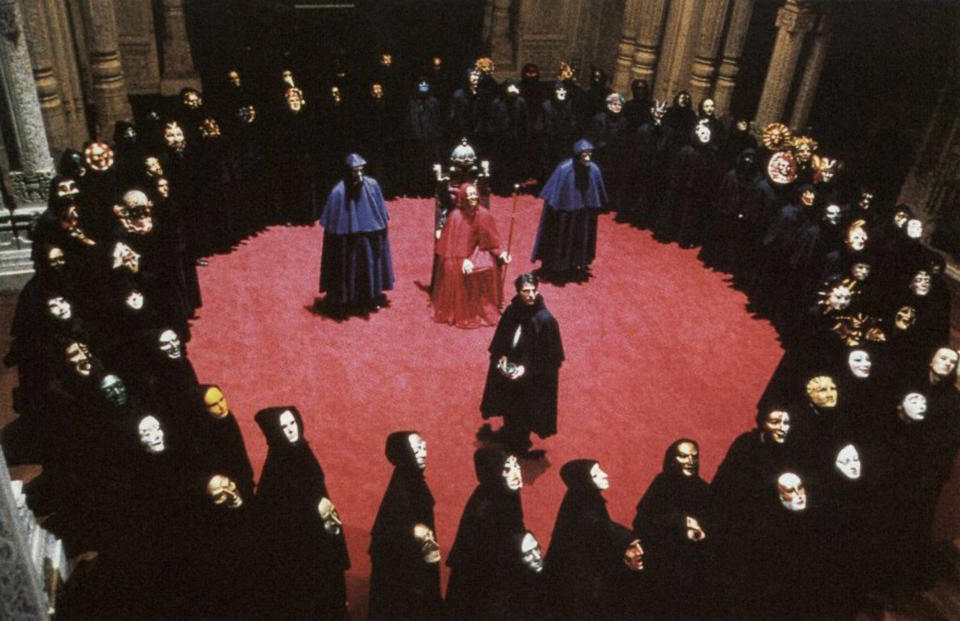
“There’s something we need to do as soon as possible: Fuck.” So ends Stanley Kubrick’s swan song, his erotic journey into the inner dream lives of Alice (Nicole Kidman) and Bill (Tom Cruise) Hartford, who share stories of sexual close encounters and brush up against potentially marriage-destroying infidelity. Casual moviegoers were surely stunned in the summer of 1999 when a film marketed as a sort of peek into the sex lives of its marquee-dominating stars turned out to be a cerebral, psychosexual art film aligned more with the sensibilities of its exacting director than its submitting cast.
But the one scene that still drives viewers to revisit or for the first time discover “Eyes Wide Shut” is its centerpiece masquerade orgy, a Boschian bacchanalia of parts and limbs and a moment only Kubrick could dream of. Under contractual obligation to deliver an R-rating, distributor Warner Bros. wound up censoring the sequence, with digitally inserted figures to obscure the most titillating bits of this wild mass sex scene. Seen as was originally intended, the scene is hysterical in its excess and crucial to the narrative as a moment meant to humiliate and overwhelm the sexually stunted Bill. It’s his fantasies realized, but grotesque and warped and ultimately terrifying. You can see the full uncensored version on the film’s home release. It’s the version Kubrick, who died just before the movie was released, no doubt would prefer. —RL
“Requiem for a Dream” (Darren Aronofsky, 2000)

It would be wildly atonal for “Requiem for a Dream” to play nudity from any of its cast members as fanservice; Darren Aronofsky’s drug addiction drama is a notoriously brutal watch drenched in sadness and despair. So when Jennifer Connolly takes off her clothes for a brief scene at the film’s conclusion, it’s not to highlight her beauty but to demonstrate how fall her character Marion has fallen. By the end of the movie, every character has fallen prey to the effects of heroin and drug abuse, and end up in desperate circumstances. But Marion gets it particularly rough, resorting to working as a prostitute and participating in group sex shows to get her fix. Her “double dildo” show in the film’s final quick cut montage is never played as anything less than horrifying, and Aronofsky doesn’t allow for even a sliver of sensuality in how he shoots it. It’s a key example of how nudity in film doesn’t always have to be (or should be) hot. —WC
“Y Tu Mama Tambien” (Alfonso Cuarón, 2001)
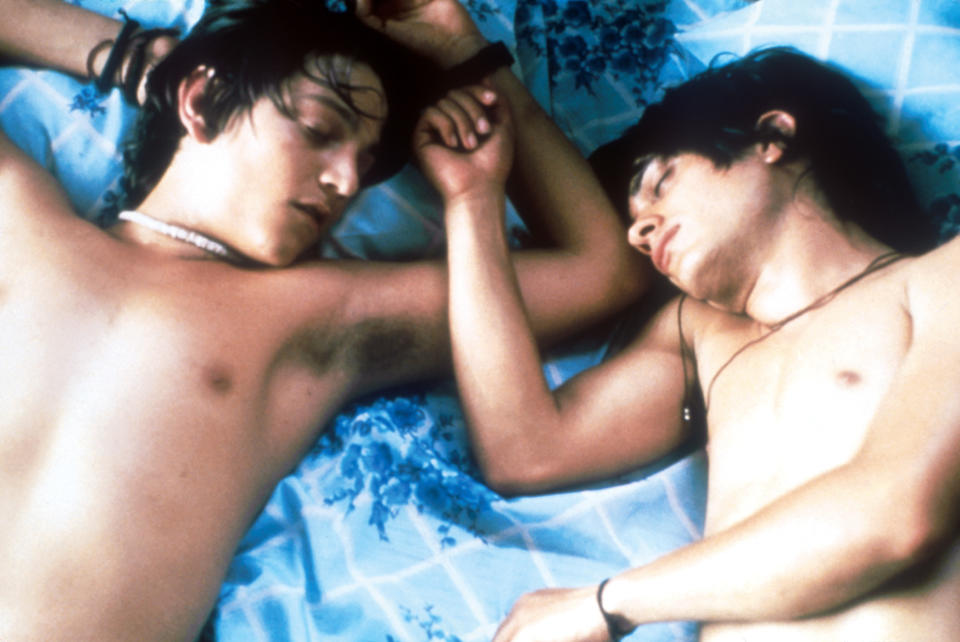
Alfonso Cuarón, an established maker of stately English-language dramas like “A Little Princes” and “Great Expectations,” burst onto the international film landscape with “Y Tu Mamá También,” a sexy and bittersweet movie that broke into the Oscar race (with a Best Original Screenplay nomination) and the box office despite its lack of an MPAA rating. From its opening shot, “Y Tu” is relentlessly graphic in its depictions of sexuality and nudity as revolving around the erotic triangle of hormone-addled, 17-year-old best friends Tencho (Diego Luna) and Julio (Gael García Bernal) and an older and alluring woman named Luisa (Maribel Verdu) with a secret. While you could pick any from a handful of nude scenes, perhaps the movie’s most transgressive is at the beginning of a threesome where Luisa makes herself the third wheel, leaving room for Julio and Tenoch to, if fleetingly, explore the obvious erotic charge between them. Both García Bernal and Luna bare all throughout the film, but it’s in this tender moment of undress that their characters ultimately bare something deeper and intractable. —RL
“Monster’s Ball” (Marc Forster, 2001)

Halle Berry became the first Black woman to win the Best Actress Oscar in 2002 for this Southern-set frenzy of grief. (She also remains the last Black woman to do so.) While Berry appeared topless in the sleazy caper “Swordfish” earlier that year, it was her bare-all, history-making performance in manners psychological, emotional, and literal that garnered critical acclaim. She plays Letitia Musgrove, a widower who forms a friendship with Hank (Billy Bob Thornton), the corrections officer who oversaw her convicted-murderer husband’s execution. Over the course of the film, both of them lose their only children, sending them into a moment of amour fou grief spiral of sex as Letitia begs Hank, “I just want to feel good.” Berry strips down for the scene, but that’s not where its power lies — instead, it’s in how nakedly raw-nerved she is in this moment where she happens to also be naked. —RL
“The Dreamers” (Bernardo Bertolucci, 2003)

“Last Tango in Paris” director Bernardo Bertolucci was never one to shy away from nudity or sexuality in its most brute or animalistic forms. “The Dreamers” might be his sweetest movie, a provocatively told story of the erotic triangulation of a too-close brother and sister (Louis Garrel and Eva Green) and the American university student they take under their wing (and into their bedroom) amid the chaotic climate of 1968 Paris. Their cinematic reference–filled mind games take on greater stakes as the movie progresses. One scene finds Isabelle (Green) doing a striptease to Charles Trenet’s “La Mer” at her brother Theo’s (Garrel) behest as part of their manipulations, leading Theo to hold Matthew (Michael Pitt) down as Isabelle strips him and they have a graphic sexual encounter on the kitchen floor. In a film full of all possible nude scenes from all three actors, this one moment stands out as the apex of their twisted games. —RL
“Shortbus” (John Cameron Mitchell, 2006)

When John Cameron Mitchell’s sophomore feature “Shortbus” came out in 2006, it initially evoked titters from critics due to its multiple unsimulated sex scenes. Yes, “Shortbus” is unique because it features real sex — some of the most playful, acrobatic, and creative sex you’ll ever witness — but it’s also incredibly moving. Set during the blackout of 2003, the film follows a group of emotionally stunted characters navigating sex and desire in a post-9/11, Bush-addled New York. There’s a sex therapist who’s never had an orgasm; a gay man obsessively filming himself as an artful suicide note; and a disaffected dominatrix. Mitchell’s films are always hilarious, provocative, and deeply felt, but in “Shortbus” he weaves multiple compelling narratives (not an easy feat) into a gorgeous revery of a bohemian New York that was already slipping away. Set in the early aughts, the film has a timeless nostalgia about it, like a time capsule of some bygone era of sexual freedom that maybe everyone feels they just barely missed out on. —JD
“Eastern Promises” (David Cronenberg, 2007)

While it lacks the sexiness of many other films on this list, David Cronenberg’s “Eastern Promises” has to have one of the best nude fight scenes in film history. While two criminals attempt to conduct a covert meeting in a bathhouse, their steam is interrupted by two Chechen hitmen seeking to kill them. The towels quickly fall, and viewers are treated to an absolutely brutal full-frontal action sequence. It is an excellent use of nudity in film because it is so believable — when assassins ambush you in a sauna, there is no time to find a strategically placed towel — resulting in a memorable nude scene that never feels gratuitous. —CZ
“Lust, Caution” (Ang Lee, 2007)

From “Hulk” to “Brokeback Mountain” to “Lust, Caution” is quite a pivot for any director, but this trio of films from Ang Lee shows his immense range and, in the case of the latter two films, his keen eye for capturing the complexities of sexuality against shifting social backdrops. The sex scenes in “Lust, Caution” — which was released with an NC-17 rating stateside by Focus Features — while simulated, approach “In the Realm of the Senses” levels of explicitness. In World War II, the marvelous Tang Wei plays a secret agent assigned to seduce and then assassinate an official working for the Japanese government in Shanghai, played by Wong Kar Wai favorite Tony Leung Chiu. The movie was emotionally taxing for both actors, who appear full-frontal at various points as their relationship takes on more passionate dimensions. Most of the sex scenes were cut from release in mainland China per the country’s reigning censorship laws, but “Lust, Caution” proved that, in 2007, an erotic epic that feels like a movie out of the 1970s could still break into the fray. There’s hardly been a film of its operatic scope and grandly staged eroticism since. —RL
“Forgetting Sarah Marshall” (Nicholas Stoller, 2008)

Jason Segel was behind — and did full-frontal for — the brilliant nude scene that opens “Forgetting Sarah Marshall”: Nicholas Stoller’s 2008 breakup comedy co-starring Kristen Bell. In the scene, hapless hero Peter Bretter gets the devastating news that his A-list actress girlfriend is leaving him, while totally in the buff.
“There was a part that we ended up cutting from the script — this is actually what happened — where he chose the outfit that as he put it ‘he’d be broken up in,'” the director told Entertainment Weekly in 2019. “He was like picking a shirt that his girlfriend at the time had bought for him to make her feel really bad. But it just slowed down the scene so we ended up not doing that.”
The juxtaposition of Peter’s seemingly boundless despair and intense visual vulnerability proved the smarter choice. Stoller said of Segel’s approach to the scene, “He was mainly nervous that his wiener look normal, which in a very cold stage is hard to achieve. So he had set up a private room where he got his wiener looking normal. And Kristen and I just waited and he’d yell, ‘Okay, I’m ready,’ and then I’d say action and he’d run out to do the scene.” —AF
“Antichrist” (Lars Von Trier, 2009)

Of course we had to put the film that informed the world about Willem Dafoe’s confusingly large penis on this list. Lars Von Trier’s “Antichrist” doesn’t really beat around the bush, quite literally opening with a bang, on a slo-mo shot of Dafoe’s unnamed character engaging in vigorous shower sex with his wife (played by Charlotte Gainsbourg). Just to make sure the audience knows exactly how far the two go, Tier inserts a close-up shot of a anal penetration to go along with the steamy close-up shots. Neither Dafoe nor Gainsbourg actually participated in that notorious shot, which was created with body doubles, but the effect is still disorienting — especially when its contrasted with the horrifying sequence where the two’s infant son climbs up to their apartment’s window and plummets to his death. The interplay between, sex, tragedy, and violence is at the core of Tier’s audacious art film, which lingers on to track the fallout and emotional destruction that results from the child’s death, and the operatically lewd opening sets a tone that will no doubt entice some audience members and repulse others. —WC
“Shame” (Steve McQueen, 2011)

The word “brave” gets grossly tossed around with abandon toward women who take on roles that de-glam and de-face their sex symbol status, and the fact that “bravery” is a term typically reserved for women stinks of sexism. Enter Steve McQueen’s “Shame” to flip the script on that broadly applied label with a Michael Fassbender turn that certainly required a level of particularly male fearlessness. As sex addict Brandon, Fassbender is in various forms of undress and head-in-his-hands despair throughout the movie, clearly psychosexually tormented by a too-close relationship with his suicidal sister (Carey Mulligan) and unable to achieve orgasm (which he needs constantly) unless it’s completely without intimacy. However, in the film’s opening montage, which serves to clinically diagram Brandon’s mundane routine of sleep, work, and sex, a fully nude Fassbender walks past the camera, his penis in full view. Full-frontal male nudity of that kind from a major star remains rare on any screen, and McQueen is obviously toying with that expectation in the film’s first moments. Even in 2011, the shot delivered quite the jolt — only to dissolve into the rest of an extremely sad, rigidly, beautifully composed, but mostly thereafter empty movie. —RL
“Gone Girl” (David Fincher, 2014)
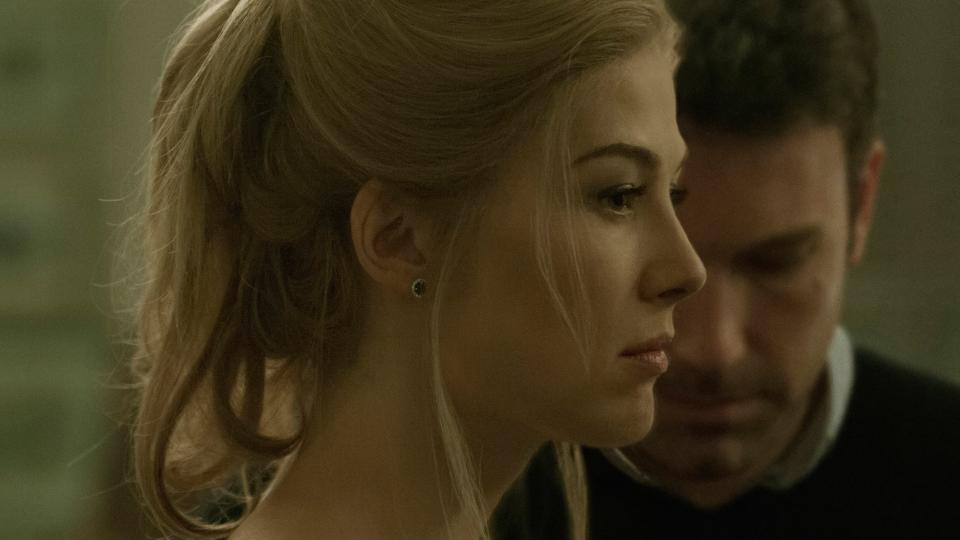
It says something about how much nudity has disappeared in cinema that Ben Affleck’s moment in the buff during “Gone Girl” caused as much of a stir as it did. The star strips down in the climatic scene of David Fincher’s blockbuster adaptation of Gillian Flynn’s popular novel, but we only get a glimpse of his package for a second as his character Nick hops into the shower to chat with his wife/nemesis Amy (Rosamund Pike). Affleck’s nudity is a vital component for the scene, which is less about sexiness than it is about the twisted dynamics of Nick and Amy’s marriage — wrapped in counteraccusations and the possibility that either of them could be wearing a wire. After feeling trapped and powerless in her relationship for years, Amy staged a disappearance in an attempt to frame Nick for her murder, only to come back pregnant and intending to force Nick to stay with her. By forcing him to strip down, Amy makes it clear who’s in control in their holy matrimony now, and who the vulnerable party really is. —WC
“Love” (Gaspar Noé, 2015)

Gaspar Noé’s sexy, sad, and luridly stylized erotic epic “Love” boasts wall-to-wall unsimulated sex scenes between Karl Glusman, Aomi Muyock, Klara Kristin, and whoever else they’re willing to bed throughout the course of the movie, which revolves around the destructive fallout of their love triangle. You could pick really any scene in this movie and run with it — a closeup of Glusman ejaculating, when viewed in 3D as the movie originally screened, is something to see —but you might as well start with the very first one because it brazenly announces what Noé is trying to achieve. Glusman and Muyock are fully nude, artfully lit, intertwined, fingering and jerking each other off to the finish. Noé, working with his beloved cinematographer Beno?t Debie, films the scene in entirely one take, and it actually makes for quite tender viewing. From the director of films like “Irreversible,” featuring a 10-minute uninterrupted sexual assault, and “Climax,” which features a small child tripping on LSD who gets electrocuted inside a locked utility closet, this may be his sweetest moment ever. It also brought nudity and unsimulated sex back to the arthouses in a major way. —RL
“Red Rocket” (Sean Baker, 2021)

While Sean Baker’s “Red Rocket” earned rave reviews for being a compelling character study about a narcissistic former porn star returning to his hometown, it received much more attention for Simon Rex’s penis than any artistic choice that Baker made. The actor’s particularly large appendage was the subject of plenty of jokes (and admiration), although the star recently admitted that he used a prosthetic. “I just had fun with it, and me and Sean Baker…we agreed that we were going to keep it mysterious, and not say whether or not that was really me naked,” Rex said. “And at that point, after we won the Spirit Award, I said, ‘It’s time to tell people.’” However, anyone who has seen the film can agree that the use of Hollywood magic did not make a certain nude running scene any less memorable. —CZ
“No Hard Feelings” (Gene Stupnitsky, 2023)

The question hanging over “No Hard Feelings” the entire time is whether or not the leads Maddie (Jennifer Lawrence) and Percy (Andrew Barth Feldman) will successfully get it on; a mortifying mental image, when you consider the fact that Maddie is a 32-year-old woman hired by 19-year-old Percy’s parents to “date” him and get him out of his shell before he heads off to Princeton in the fall. Thankfully though, the only actual nude scene in Gene Stupnitsky’s far more earnest than you’d expect comedy doesn’t involve Maddie and Percy consummating their mortifyingly awkward summer fling. Instead, it finds Maddie — having shed her outfit to skinny dip in the ocean in an attempt to seduce her young ticket to a new Buick Regal — forced to viciously fight a group of teenagers who steal her clothes. Lawrence really goes for it, punching and kicking her foes wildly, and getting kicked in the crotch in return. Her nudity in the scene comes across less sexy than it does animalistic, a hilariously memorable showcase of how these circumstances are pushing Maddie to truly desperate lows. —WC
Best of IndieWire
Sign up for Indiewire's Newsletter. For the latest news, follow us on Facebook, Twitter, and Instagram.
Solve the daily Crossword

